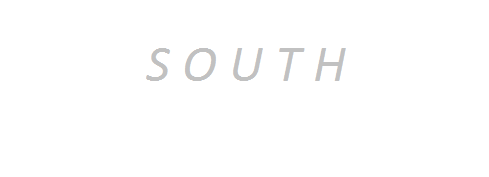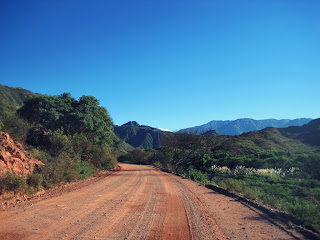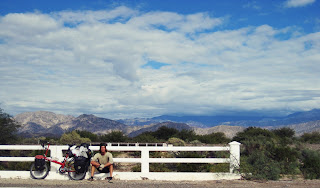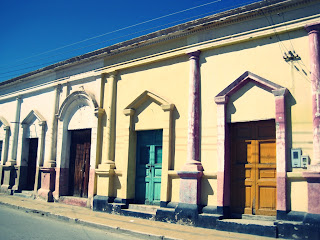Horses awakened me in the night. Two had come down into the red dirt clearing beside my tent and were stomping on the ground and grunting. I lay still, making no noise until they left. I awoke later with the glow of the sun coming up behind the red mountains. Everything was still. The zonda was not blowing. I checked for new flea bites and did not find any. I made a coffee and packed up.
The road wound up higher into the mountains through fields of cactus and streams flowed over the road and then there was a tall wall of mountains and there Ruta 40 became a series of long switchbacks up it. It was the Cuesta de Miranda. The road steepened but the red dirt ripio was gravelly enough that I had traction and I struggled up the pass and then through a corridor of red rock and the road continued higher until the marker at the top.
Then it was down, down on a narrow ripio road overlooking the gorge and with no guardrail you could not make any mistakes. The ripio was washboard in places and thick sand and it was dangerous to look to much at the scenery as you descended. It was a long descent that I took slowly and then I was down into the valley along the river and I hit asphalt again.
I stopped to eat some cookies and saw my rear left pannier was hanging on the rack by only one hook. I looked more closely and saw the other hook had been torn free from the rivets that held it to the pannier. With two screws, nuts and washers I reattached the hook. Something always seemed to break on the ripio.
The road descended slowly from the pass following along the river and then near Nanogasta the descent steepened and I blew through that town, the valley now stretching out in front and a new range of mountains, and I coasted into the neighboring town of Sanogasta. I stopped and bought some water at a service station and then headed up Ruta 40, now ascending, towards Chilecito.
In the midday heat it was a long 20 km ascent to Chilecito and I stopped in a bar and drank and coffee and a sparkling water. I had hoped to do some shopping at 4 pm when I expected the siesta to end, but here in Chilecito the siesta ended at 6 pm. It was that way throughout this region I was told. I supposed it was because of the hotter temperatures.
I waited around until 6 pm and found a kiosk near the edge of town. The old man there was a former cyclist and said that I should stay the night at the youth center around the corner. I could stay there for free and get a bed and a shower. I preferred to wild camp off the roadside but he was insistent and I finally said that I would take a look.
Inside the youth center there were young boys playing basketball. A man who ran the place said there was a room and that he would call another man who would bring the key to open it. Hours later the man had still not come. I said that I didn’t need the room and would just put up my tent in the room beside the bathroom. I was tired and wanted to cook up some pasta and to go to sleep.
Then around 2 am someone on the street starts banging on the window to my room and calling into it. He must be able to see the tent and he’s asking me to open the door of the youth center. I don’t say anything hoping he’ll go away, but he keeps calling into my room. Finally, I speak out in English and tell him to get out. I start yelling at him but he won’t shut up. After 5 minutes of this he finally leaves.
10 minutes later I hear somebody inside the center. I can hear two people talking. I quickly unzip my tent and unfold my knife. I see them through the venting on the windows of the room walking towards my door. It looks like two teenagers. They start pushing at my doors. The desk is scraping across the floor as the doors push inward. They’re coming in. I creep up to the doors in the darkness. When the door is open almost enough for one to come in I jump into the light and yell “BOO!” which causes the one at the door to run. The other boy is standing there, terrified. I step into the crack of the doorway and start yelling at him in English and giving him the crazy eyes. Maybe he sees the knife too, I didn’t care. He’s not saying a thing. I want to keep it all in english--my language. I want every advantage.
I can see he's real scared and I mix in a little Spanish and ask him why he’s in here, the center is closed. His friend, hearing the Spanish, has now come back. I don’t like the look of this kid at all with the tattoos and the piercings. He asks me if he can come in and get a drink of water from the sink inside my room. No, I tell him. I’m sleeping here. Go home, I tell them. Then I get loud and start insulting both of them in English and give them the crazy eyes one more time and shut the door and push the desk up against it. I hear them leave. I hoped I scared them enough not to come back.
I didn’t sleep much after that. I was worried they might return with their friends or with weapons. I didn’t know and had to be prepared for anything. I pushed a second desk up against the door and put a beer bottle and a broom handle near my tent as other weapons I could use. It was past 3 am. I must have dozed off because the next thing I remember it was 6 am and the housekeeper was knocking on the door asking to be let in.



















































